
IdentificationPhysical DataSpectraRoute of Synthesis (ROS)Safety and HazardsOther Data
Identification
Product NameNickel(II) tetramethoxyphenylporphyrinIUPAC Namenickel(2+);5,10,15,20-tetrakis(4-methoxyphenyl)porphyrin-22,24-diideMolecular StructureCAS Registry Number 39828-57-4MDL NumberMFCD07787297Synonyms39828-57-4nickel(2+);5,10,15,20-tetrakis(4-methoxyphenyl)porphyrin-22,24-diideWIHHBQHMISDZOC-NHZJRHMYSA-NNickel(II)tetramethoxyphenylporphyrinNickel, -, (SP-4-1)-Molecular FormulaC48H36N4NiO4Molecular Weight791.5InChIInChI=1S/C48H36N4O4.Ni/c1-53-33-13-5-29(6-14-33)45-37-21-23-39(49-37)46(30-7-15-34(54-2)16-8-30)41-25-27-43(51-41)48(32-11-19-36(56-4)20-12-32)44-28-26-42(52-44)47(40-24-22-38(45)50-40)31-9-17-35(55-3)18-10-31;/h5-28H,1-4H3;/q-2;+2InChI KeyWIHHBQHMISDZOC-UHFFFAOYSA-NIsomeric SMILESCOC1=CC=C(C=C1)C2=C3C=CC(=C(C4=NC(=C(C5=CC=C(5)C(=C6C=CC2=N6)C7=CC=C(C=C7)OC)C8=CC=C(C=C8)OC)C=C4)C9=CC=C(C=C9)OC)3.
Physical Data
AppearancePurple powder
Spectra
Description (NMR Spectroscopy)Nucleus (NMR Spectroscopy)Solvents (NMR Spectroscopy)Temperature (NMR Spectroscopy), °C Frequency (NMR Spectroscopy), MHzChemical shifts, Spectrum1Hdichloromethane-d2Chemical shifts, Spectrum1Hchloroform-d125Chemical shifts, Spectrum13Cchloroform-d125Chemical shifts, Spectrum1Hchloroform-d126.84500
Description (IR Spectroscopy)Spectrum
Description (UV/VIS Spectroscopy)Solvent (UV/VIS Spectroscopy)Absorption maximaH2O, NaOH
Route of Synthesis (ROS)
Route of Synthesis (ROS) of Nickel(II) tetramethoxyphenylporphyrin CAS# 39828-57-4
ConditionsYieldWith phenoxathiinyl hexachloroantimonate In dichloromethane at 20℃;
Safety and Hazards
GHS Hazard StatementsNot Classified
Other Data
Shelf Life1 yearMarket Price
DruglikenessLipinski rules componentMolecular Weight791.528logPHBA8HBD0Matching Lipinski Rules2Veber rules componentPolar Surface Area (PSA)43.4Rotatable Bond (RotB)8Matching Veber Rules2
Use PatternNickel(II) tetramethoxyphenylporphyrin CAS 39828-57-4 is a metalloporphyrin compound with unique optical, electrochemical, and catalytic properties. Nickel(II) tetramethoxyphenylporphyrin can serve as a catalyst for various oxidation reactions, such as the epoxidation of alkenes and hydroxylation of alkanes. Its high catalytic efficiency makes it valuable in organic synthesis. It can also be used to catalyze reduction reactions, such as hydrogenation and electrochemical reduction reactions.
https://www.chemwhat.com/nickelii-tetramethoxyphenylporphyrin-cas-39828-57-4/
Comments
Post a Comment